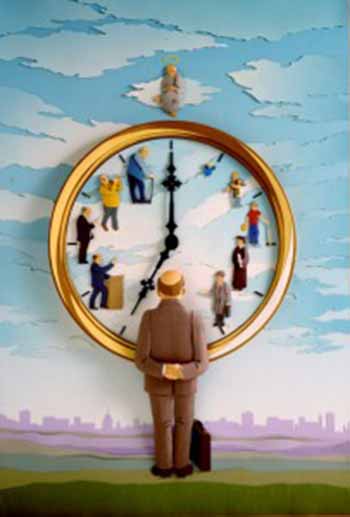

A circadian rhythm is any biological process that displays an endogenous, entrainable oscillation of about 24 hours. These rhythms are driven by a circadian clock, and rhythms have been widely observed in plants, animals, fungi and cyanobacteria. The term circadian comes from the Latin circa, meaning "around" (or "approximately"), and diem or dies, meaning "day". The formal study of biological temporal rhythms, such as daily, tidal, weekly, seasonal, and annual rhythms, is called chronobiology. Although circadian rhythms are endogenous ("built-in", self-sustained), they are adjusted (entrained) to the local environment by external cues called zeitgebers, commonly the most important of which is daylight.
A "master clock" in the brain coordinates all the body clocks so that they are in synch. This master cock controls circadian rhythms consists of a group of nerve cells in the brain called the suprachiasmatic nucleus, or SCN. The SCN contains about 20,000 nerve cells and is located in the hypothalamus, an area of the brain just above where the optic nerves from the eyes cross.
Circadian rhythms are produced by natural factors within the body, but they are also affected by signals from the environment. Light is the main cue influencing circadian rhythms, turning on or turning off genes that control an organism's internal clocks.
Circadian rhythms can influence sleep-wake cycles, hormone release, body temperature and other important bodily functions. They have been linked to various sleep disorders, such as insomnia. Abnormal circadian rhythms have also been associated with obesity, diabetes, depression, bipolar disorder and seasonal affective disorder.
Circadian rhythms are important in determining human sleep patterns. The body's master clock, or SCN, controls the production of melatonin, a hormone that makes you sleepy. Since it is located just above the optic nerves, which relay information from the eyes to the brain, the SCN receives information about incoming light. When there is less light - like at night - the SCN tells the brain to make more melatonin so you get drowsy.
Disruption to rhythms usually has a negative effect in the short term. Many travelers have experienced the condition known as jet lag, with its associated symptoms of fatigue, disorientation and insomnia. Jet lag occurs when travelers suffer from disrupted circadian rhythms. When you pass through different time zones, your body's clock will be different from your wristwatch.
The term "circadian" comes from the Latin circa, "around", and dies, "day", meaning literally "about a day." The formal study of biological temporal rhythms such as daily, weekly, seasonal, and annual rhythms, is called chronobiology.
Although circadian rhythms are endogenous ("built-in", self-sustained), they are adjusted (entrained) to the environment by external cues called zeitgebers, the primary one of which is daylight. In a strict sense, circadian rhythms are endogenously generated, although they can be modulated by external cues such as sunlight and temperature.
To be called circadian, a biological rhythm must meet these four general criteria:
1. The rhythms repeat once a day (they have a 24-hour period). In order to keep track of the time of day, a clock must be at the same point at the same time each day, i.e. repeat every 24 hours.
2. The rhythms persist in the absence of external cues (endogenous). The rhythm persists in constant conditions with a period of about 24 hours. The rationale for this criterion is to distinguish circadian rhythms from simple responses to daily external cues. A rhythm cannot be said to be endogenous unless it has been tested in conditions without external periodic input.
3. The rhythms can be adjusted to match the local time (entrainable). The rhythm can be reset by exposure to external stimuli (such as light and heat), a process called entrainment. The rationale for this criterion is to distinguish circadian rhythms from other imaginable endogenous 24-hour rhythms that are immune to resetting by external cues, and hence do not serve the purpose of estimating the local time. Travel across time zones illustrates the ability of the human biological clock to adjust to the local time; a person will usually experience jet lag before entrainment of their circadian clock has brought it into sync with local time.
4. The rhythms maintain circadian periodicity over a range of physiological temperatures; they exhibit temperature compensation. Some organisms live at a broad range of temperatures, and differences in thermal energy will affect the kinetics of all molecular processes in their cell(s). In order to keep track of time, the organism's circadian clock must maintain a roughly 24-hour periodicity despite the changing kinetics, a property known as temperature compensation.
Circadian rhythms are believed to have originated in the earliest cells to provide protection for replicating DNA, from high ultraviolet radiation during day-time. As a result, replication was relegated to the dark. The fungus Neurospora, which exists today, retains this clock-regulated mechanism.
The simplest known circadian clock is that of the prokaryotic cyanobacteria. Recent research has demonstrated that the circadian clock of Synecohococcus elongatus can be reconstituted in vitro with just the three proteins of their central oscillator. This clock has been shown to sustain a 22 hour rhythm over several days upon the addition of ATP.
Previous explanations of the prokaryotic circadian timekeeper were dependent upon a DNA transcription / translation feedback mechanism, and although this has not been shown to be the case, it is still believed to hold true for eukaryotic organisms. Indeed, although the circadian systems of eukaryotes and prokaryotes have the same basic architecture: input - central oscillator - output, they do not share any homology. This implies probable independent origins.
-
Photosensitive proteins and circadian rhythms are believed to have originated in the earliest cells, with the purpose of protecting the replicating of DNA from high ultraviolet radiation during the daytime. As a result, replication was relegated to the dark. The fungus Neurospora, which exists today, retains this clock-regulated mechanism.
Circadian rhythms allow organisms to anticipate and prepare for precise and regular environmental changes; they have great value in relation to the outside world. The rhythmicity appears to be as important in regulating and coordinating internal metabolic processes, as in coordinating with the environment. This is suggested by the maintenance (heritability) of circadian rhythms in fruit flies after several hundred generations in constant laboratory conditions, as well as in creatures in constant darkness in the wild, and by the experimental elimination of behavioral but not physiological circadian rhythms in quail.
The simplest known circadian clock is that of the prokaryotic cyanobacteria. Recent research has demonstrated that the circadian clock of Synechococcus elongatus can be reconstituted in vitro with just the three proteins of their central oscillator. This clock has been shown to sustain a 22-hour rhythm over several days upon the addition of ATP. Previous explanations of the prokaryotic circadian timekeeper were dependent upon a DNA transcription/translation feedback mechanism.
A defect in the human homologue of the Drosophila "period" gene was identified as a cause of the sleep disorder FASPS (Familial advanced sleep phase syndrome), underscoring the conserved nature of the molecular circadian clock through evolution. Many more genetic components of the biological clock are now known. Their interactions result in an interlocked feedback loop of gene products resulting in periodic fluctuations that the cells of the body interpret as a specific time of the day.
It is now known that the molecular circadian clock can function within a single cell; i.e., it is cell-autonomous. At the same time, different cells may communicate with each other resulting in a synchronized output of electrical signaling. These may interface with endocrine glands of the brain to result in periodic release of hormones. The receptors for these hormones may be located far across the body and synchronize the peripheral clocks of various organs. Thus, the information of the time of the day as relayed by the eyes travels to the clock in the brain, and, through that, clocks in the rest of the body may be synchronized. This is how the timing of, for example, sleep/wake, body temperature, thirst, and appetite are coordinately controlled by the biological clock.
Circadian rhythmicity is present in the sleeping and feeding patterns of animals, including human beings. There are also clear patterns of core body temperature, brain wave activity, hormone production, cell regeneration and other biological activities. In addition, photoperiodism, the physiological reaction of organisms to the length of day or night, is vital to both plants and animals, and the circadian system plays a role in the measurement and interpretation of day length.
-
The rhythm is linked to the light-dark cycle. Animals, including humans, kept in total darkness for extended periods eventually function with a free-running rhythm. Their sleep cycle is pushed back or forward each "day", depending on whether their "day", their endogenous period, is shorter or longer than 24 hours. The environmental cues that reset the rhythms each day are called zeitgebers (from the German, "time-givers"). It is interesting to note that totally-blind subterranean mammals (e.g., blind mole rat Spalax sp.) are able to maintain their endogenous clocks in the apparent absence of external stimuli. Although they lack image-forming eyes, their photoreceptors (which detect light) are still functional; they do surface periodically as well.
Free-running organisms that normally have one or two consolidated sleep episodes will still have them when in an environment shielded from external cues, but the rhythm is, of course, not entrained to the 24-hour light-dark cycle in nature. The sleep-wake rhythm may, in these circumstances, become out of phase with other circadian or ultradian rhythms such as metabolic, hormonal, CNS electrical, or neurotransmitter rhythms.
Recent research has influenced the design of spacecraft environments, as systems that mimic the light-dark cycle have been found to be highly beneficial to astronauts.
-
Norwegian researchers at the University of Tromso have shown that some Arctic animals (ptarmigan, reindeer) show circadian rhythms only in the parts of the year that have daily sunrises and sunsets. In one study of reindeer, animals at 70 degrees North showed circadian rhythms in the autumn, winter, and spring, but not in the summer. Reindeer at 78 degrees North showed such rhythms only in autumn and spring. The researchers suspect that other Arctic animals as well may not show circadian rhythms in the constant light of summer and the constant dark of winter.
However, another study in northern Alaska found that ground squirrels and porcupines strictly maintained their circadian rhythms through 82 days and nights of sunshine. The researchers speculate that these two small mammals see that the apparent distance between the sun and the horizon is shortest once a day, and, thus, a sufficient signal to adjust by.
- <> The navigation of the fall migration of the Eastern North American monarch butterfly (Danaus plexippus) to their overwintering grounds in central Mexico uses a time-compensated sun compass that depends upon a circadian clock in their antennae
The earliest known account of a circadian process dates from the 4th century BC, when Androsthenes, a ship captain serving under Alexander the Great, described diurnal leaf movements of the tamarind tree. The observation of a circadian or diurnal process in humans is mentioned in Chinese medical texts dated to around the 13th century, including the Noon and Midnight Manual and the Mnemonic Rhyme to Aid in the Selection of Acu-points According to the Diurnal Cycle, the Day of the Month and the Season of the Year.
The first recorded observation of an endogenous circadian oscillation was by the French scientist Jean-Jacques d'Ortous de Mairan in 1729. He noted that 24-hour patterns in the movement of the leaves of the plant Mimosa pudica continued even when the plants were kept in constant darkness, in the first experiment to attempt to distinguish an endogenous clock from responses to daily stimuli.
In 1896, Patrick and Gilbert observed that during a prolonged period of sleep deprivation, sleepiness increases and decreases with a period of approximately 24 hours.
In 1918, J.S. Szymanski showed that animals are capable of maintaining 24-hour activity patterns in the absence of external cues such as light and changes in temperature. Ron Konopka and Seymour Benzer isolated the first clock mutant in Drosophila in the early 1970s and mapped the "period" gene, the first discovered genetic component of a circadian clock. Joseph Takahashi discovered the first mammalian 'clock gene' (CLOCK) using mice in 1994.
The term "circadian" was coined by Franz Halberg in the late 1950s.
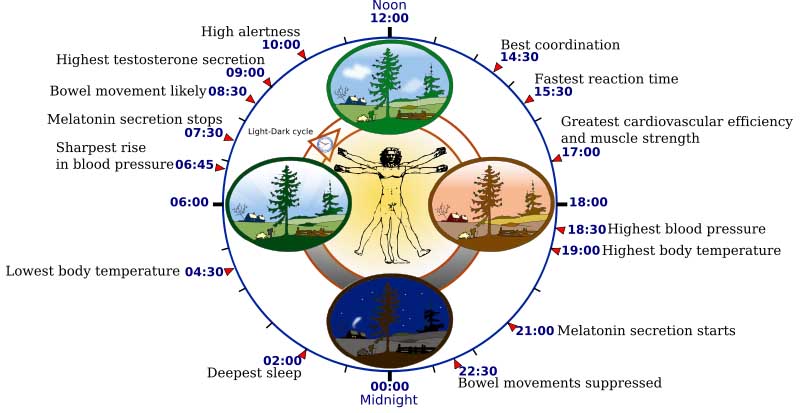
The primary circadian "clock" in mammals is located in the suprachiasmatic nucleus (or nuclei) (SCN), a pair of distinct groups of cells located in the hypothalamus. Destruction of the SCN results in the complete absence of a regular sleep-wake rhythm. The SCN receives information about illumination through the eyes. The retina of the eye contains "classical" photoreceptors ("rods" and "cones"), which are used for conventional vision. But the retina also contains specialized ganglion cells which are directly photosensitive, and project directly to the SCN where they help in the entrainment of this master circadian clock.
These cells contain the photopigment melanopsin and their signals follow a pathway called the retinohypothalamic tract, leading to the SCN. If cells from the SCN are removed and cultured, they maintain their own rhythm in the absence of external cues.
The SCN takes the information on the lengths of the day and night from the retina, interprets it, and passes it on to the pineal gland, a tiny structure shaped like a pine cone and located on the epithalamus. In response, the pineal secretes the hormone melatonin. Secretion of melatonin peaks at night and ebbs during the day and its presence provides information about night-length.
Several studies have indicated that pineal melatonin feeds back on SCN rhythmicity to modulate circadian patterns of activity and other processes. However, the nature and system-level significance of this feedback are unknown.
The circadian rhythms of humans can be entrained to slightly shorter and longer periods than the Earth's 24 hours. Researchers at Harvard have recently shown that human subjects can at least be entrained to a 23.5-hour cycle and a 24.65-hour cycle (the latter being the natural solar day-night cycle on the planet Mars).
Early research into circadian rhythms suggested that most people preferred a day closer to 25 hours when isolated from external stimuli like daylight and timekeeping. However, this research was faulty because it failed to shield the participants from artificial light. Although subjects were shielded from time cues (like clocks) and daylight, the researchers were not aware of the phase-delaying effects of indoor electric lights. The subjects were allowed to turn on light when they were awake and to turn it off when they wanted to sleep. Electric light in the evening delayed their circadian phase. These results became well-known.
More recent research has shown that: adults have a built-in day, which averages about 24 hours; indoor lighting does affect circadian rhythms; and most people attain their best-quality sleep during their chronotype-determined sleep periods. A study by Czeisler et al. at Harvard found the range for normal, healthy adults of all ages to be quite narrow: 24 hours and 11 minutes plus or minus 16 minutes. The "clock" resets itself daily to the 24-hour cycle of the Earth's rotation.
The classic phase markers for measuring the timing of a mammal's circadian rhythm are:
core body temperature
plasma level of cortisol.
Melatonin is absent from the system or undetectably low during daytime. Its onset in dim light, dim-light melatonin onset (DLMO), at about 21:00 (9 p.m.) can be measured in the blood or the saliva. Its major metabolite can also be measured in morning urine. Both DLMO and the midpoint (in time) of the presence of the hormone in the blood or saliva have been used as circadian markers.
However, newer research indicates that the melatonin offset may be the more reliable marker. Benloucif et al. in Chicago in 2005 found that melatonin phase markers were more stable and more highly correlated with the timing of sleep than the core temperature minimum. They found that both sleep offset and melatonin offset were more strongly correlated with the various phase markers than sleep onset. In addition, the declining phase of the melatonin levels was more reliable and stable than the termination of melatonin synthesis.
One method used for measuring melatonin offset is to analyse a sequence of urine samples throughout the morning for the presence of the melatonin metabolite 6-sulphatoxymelatonin (aMT6s). Laberge et al. in Quebec in 1997 used this method in a study that confirmed the frequently found delayed circadian phase in healthy adolescents.
A third marker of the human pacemaker is the timing of the maximum plasma cortisol level. Klerman et al. in 2002 compared cortisol and temperature data to eight different analysis methods of plasma melatonin data, and found that "methods using plasma melatonin data may be considered more reliable than methods using CBT or cortisol data as an indicator of circadian phase in humans."
Other physiological changes which occur according to a circadian rhythm include heart rate and production of red blood cells.
More-or-less independent circadian rhythms are found in many organs and cells in the body outside the suprachiasmatic nuclei (SCN), the "master clock". These clocks, called peripheral oscillators, are found in the oesophagus, lungs, liver, pancreas, spleen, thymus, and the skin.
Though oscillators in the skin respond to light, a systemic influence has not been proven so far. There is also some evidence that the olfactory bulb and prostate may experience oscillations when cultured, suggesting that these structures may also be weak oscillators. Furthermore, liver cells, for example, appear to respond to feeding rather than to light. Cells from many parts of the body appear to have freerunning rhythms.
Light resets the biological clock in accordance with the phase response curve (PRC). Depending on the timing, light can advance or delay the circadian rhythm. Both the PRC and the required illuminance vary from species to species and lower light levels are required to reset the clocks in nocturnal rodents than in humans.
Lighting levels that affect the circadian rhythm in humans are higher than the levels usually used in artificial lighting in homes. According to some researchers the illumination intensity that excites the circadian system has to reach up to 1000 lux striking the retina.
In addition to light intensity, wavelength (or color) of light is a factor in the entrainment of the body clock. Melanopsin is most efficiently excited by light from the blue part of the spectrum (420-440 nm according to some researchers while others have reported 470-485 nm). These blue wavelengths are present in virtually all light sources, therefore their elimination requires special lights or filters which appear amber.
It is thought that the direction of the light may have an effect on entraining the circadian rhythm; light coming from above, resembling an image of a bright sky, has greater effect than light entering our eyes from below.
According to a 2010 study completed by the Lighting Research Center, daylight has a direct effect on circadian rhythms and, consequently, on performance and well-being. The research showed that students who experience disruption in lighting schemes in the morning consequently experience disruption in sleeping patterns. The change in sleeping patterns may lead to negatively impacted student performance and alertness. Removing circadian light in the morning delays the dim light melatonin onset by 6 minutes a day, for a total of 30 minutes for five days.
Timing of medical treatment in coordination with the body clock may significantly increase efficacy and reduce drug toxicity or adverse reactions. For example, appropriately timed treatment with angiotensin converting enzyme inhibitors (ACEi) may reduce nocturnal blood pressure and also benefit left ventricular (reverse) remodeling.
A number of studies have concluded that a short period of sleep during the day, a power-nap, does not have any measurable effect on normal circadian rhythms, but can decrease stress and improve productivity.
There are many health problems associated with disturbances of the human circadian rhythm, such as seasonal affective disorder (SAD), delayed sleep phase syndrome (DSPS) and other circadian rhythm disorders. Circadian rhythms also play a part in the reticular activating system, which is crucial for maintaining a state of consciousness. In addition, a reversal in the sleep-wake cycle may be a sign or complication of uremia, azotemia or acute renal failure.
Studies have also shown that light has a direct effect on human health because of the way it influences the circadian rhythms.
Due to the work nature of airline pilots, who often traverse multiple timezones and regions of sunlight and darkness in one day, and spend many hours awake both day and night, they are often unable to maintain sleep patterns that correspond to the natural human circadian rhythm; this situation can easily lead to fatigue. The NTSB cites this situation as a contributing factor to many accidents and has conducted multiple research studies in order to find methods of combating fatigue in pilots.
Circadian rhythm sleep disorders are a family of sleep disorders affecting, among other things, the timing of sleep. People with circadian rhythm sleep disorders are unable to sleep and wake at the times required for normal work, school, and social needs. They are generally able to get enough sleep if allowed to sleep and wake at the times dictated by their body clocks. Unless they also have another sleep disorder, their sleep is of normal quality.
Humans, like most animals and plants, have biological rhythms, known as circadian rhythms, which are controlled by a biological clock and work on a daily time scale. These affect body temperature, alertness, appetite, hormone secretion etc. as well as sleep timing. Due to the circadian clock, sleepiness does not continuously increase as time passes. A person's desire and ability to fall asleep is influenced by both the length of time since the person woke from an adequate sleep, and by internal circadian rhythms. Thus, the body is ready for sleep and for wakefulness at different times of the day.
Sleep researcher Yaron Dagan states that "these disorders can lead to harmful psychological and functional difficulties and are often misdiagnosed and incorrectly treated due to the fact that doctors are unaware of their existence." Read more ...
Effect of drugs
Circadian rhythms and clock genes expressed in brain regions outside the suprachiasmatic nucleus may significantly influence the effects produced by drugs such as cocaine. Moreover, genetic manipulations of clock genes profoundly affect cocaine's actions.
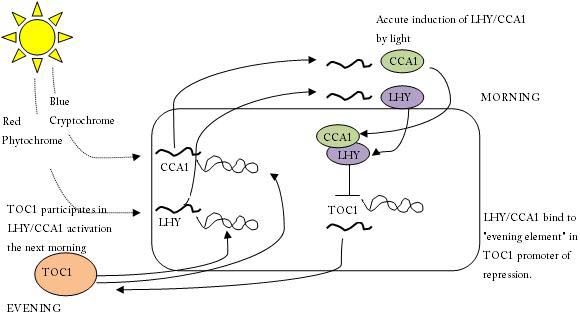
Plant circadian rhythms tell the plant what season it is in and when to flower for the best chance of attracting insects to pollinate them and can include leaf movement, growth, germination, stomatal/gas exchange, enzyme activity, photosynthetic activity, and fragrance emission.
Circadian rhythms occur as a biological rhythm with light, are endogenously generated and self-sustaining, and are relatively constant over a range of ambient temperatures. Circadian rhythms feature a transcriptional feedback loop, a presence of PAS proteins, and several photoreceptors that fine-tune the clock to different light conditions. Anticipation of changes in the environment changes the physiological state that provides plants with an adaptive advantage. A better understanding of plant circadian rhythms has applications in agriculture such as helping farmers stagger crop harvests thus extending crop availability, and to secure against massive losses due to weather.
Clocks are set through signals such as light, temperature, and nutrient availability, so that the internal time matches the local time. Light is the signal and is sensed by a wide variety of photoreceptors. Red and blue light are absorbed through several phytochromes and cryptochromes. One phytochrome, phyA, is the main phytochrome in dark-grown seedlings, but rapidly degrades in light to produce Cry1. Phytochromes B-E are more stable with phyB the main phytochrome in light-grown seedlings. The cryptochrome (cry) gene is also a light-sensitive component of the circadian clock. Cryptochromes 1-2 (involved in blue-UVA) help to maintain the period length in the clock through a whole range of light conditions.
The central oscillator generates a self-sustaining rhythm and is made of two genes: CCA1 (Circadian and Clock Associated 1) and LHY (Late Elongated Hypocotyl) that encode closely related MYB transcription factors that regulate circadian rhythms in Arabidopsis. When CCA1 and LHY are over-expressed (under constant light or dark conditions) plants become arrhythimcal and mRNA signals reduce contributing to a negative feedback loop. CCA1 and LHY expression oscillates and peaks in early morning while TOC1 oscillates and peaks in early evening. From past observations and studies, it is hypothesized that these three components model a negative feedback loop in which over-expressed CCA1 and LHY repress TOC1 and over-expressed TOC1 is a positive regulator CCA1 and LHY.
Chronobiology is a field of biology that examines periodic (cyclic) phenomena in living organisms and their adaptation to solar- and lunar-related rhythms. These cycles are known as biological rhythms. Chronobiology comes from the ancient Greek (chronos, meaning "time"), and biology, which pertains to the study, or science, of life. The related terms chronomics and chronome have been used in some cases to describe either the molecular mechanisms involved in chronobiological phenomena or the more quantitative aspects of chronobiology, particularly where comparison of cycles between organisms is required.
Chronobiological studies include but are not limited to comparative anatomy, physiology, genetics, molecular biology and behavior of organisms within biological rhythms mechanics. Other aspects include development, reproduction, ecology and evolution.
Scientists pinpoint link between light signal and circadian rhythms PhysOrg - December 29, 2010
Scientists who work in this field, known as chronobiology, have identified the genes that direct circadian rhythms in people, mice, fruit flies, fungi and several other organisms. However, the mechanisms by which those genes interact with light in the organism's environment have not been well understood.
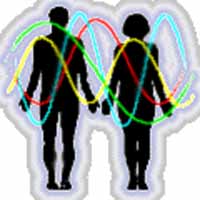
Biorhythms
In 1962 French Geologist Michel Siffre Vanished Into a Cave for 63 Days - And Emerged With a Scientific Breakthrough No One Saw Coming - The scientific field of chronobiology - the study of the body's internal clock Daily Galaxy - April 8, 2025

Light Has The Power to Shift Your Mental Health. Here's How. Science Alert - November 3, 2024
Light shining on the back of the eye sends "timing signals" to the brain and the master clock of the circadian system. This clock coordinates our daily (circadian) rhythms. "Clock genes" also regulate circadian rhythms. These genes control the timing of when many other genes turn on and off during the 24-hour, light-dark cycle. But how is this all linked with our mood and mental health? Circadian rhythms can be disrupted. This can happen if there are problems with how the body clock develops or functions, or if someone is routinely exposed to bright light at night. When circadian disruption happens, it increases the risk of certain mental disorders. These include bipolar disorder and atypical depression (a type of depression when someone is extra sleepy and has problems with their energy and metabolism).
Temperature rhythms keep body clocks in sync, researchers find PhysOrg - October 14, 2010
Researchers at UT Southwestern Medical Center have found that fluctuations in internal body temperature regulate the body's circadian rhythm, the 24-hour cycle that controls metabolism, sleep and other bodily functions. A light-sensitive portion of the brain called the suprachiasmatic nucleus (SCN) remains the body's "master clock" that coordinates the daily cycle, but it does so indirectly.
Is Age Biological Or Psychological? Here's The Science IFL Science - November 4, 2023
We're often told that age is just a number. After all, when '40 is the new 30', but then life begins at 50, it’s easy to think that none of it means anything at all. But there have to be some biological indicators of aging, don’t there - some signs in our bodies that track the passage of time? Or is it really all in the mind?
Research reveals that bacteria too have internal clocks that align with the 24-hour cycle of life on Earth PhysOrg - January 8, 2021
The research answers a long-standing biological question and could have implications for the timing of drug delivery, biotechnology, and how we develop timely solutions for crop protection. Biological clocks or circadian rhythms are exquisite internal timing mechanisms that are widespread across nature enabling living organisms to cope with the major changes that occur from day to night, even across seasons. Existing inside cells, these molecular rhythms use external cues such as daylight and temperature to synchronize biological clocks to their environment. It is why we experience the jarring effects of jet lag as our internal clocks are temporarily mismatched before aligning to the new cycle of light and dark at our travel destination.
There Are 6 Human Chronotypes, Not Just Morning Larks And Night Owls, Study Says Science Alert - December 2, 2020
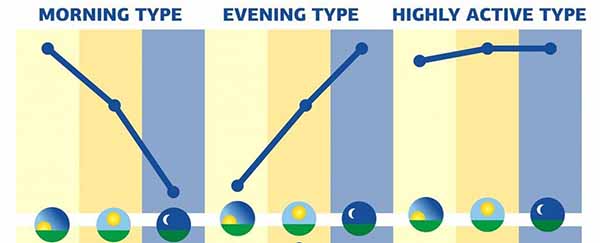
Some people are morning larks. Others are night owls. But not everybody falls neatly into those two categories, scientists say - and a new study suggests there are actually multiple distinct 'chronotypes' that define people's wakefulness and rest. Chronotypes are the behavioral manifestations of the circadian rhythms we experience throughout the day and the night. In a sense, they're your internal body clock, helping to determine whether you're a morning person or a night person. Waking life, however, isn't perhaps quite as binary as those stereotypes might suggest, and at least some evidence suggests alternative chronotypes also exist beyond early birds and night owls.
Researchers find molecular mechanisms behind women's biological clock Medical Express - October 9, 2019
Researchers have mapped out some of the mechanisms that may affect women's fertility from the teenage years to menopause. These mechanisms largely depend on naturally occurring chromosome errors - errors that vary depending on age group.
How our biological clocks are locked in sync PhysOrg - August 13, 2019
Scientists from EPFL's Institute of Bioengineering have discovered that the circadian clock and the cell-cycle are, in fact, synchronized. Nothing in biology is static; everything is fluid, dynamic and ever-moving. Often, this movement occurs in repeating patterns - regular, measurable cycles that tick just like "clocks." Two of the most important such cycles are the circadian clock, which regulates the sleep/awake rhythm, and the cell cycle, which regulates the growth, life and death of virtually every cell in the body. Considering things like sleep abnormalities, cancer, aging and other related problems, it's not hard to see why both of these cycles have gained enormous interest from researchers.
1 in 300 thrives on very-early-to-bed, very-early-to-rise routine - Many extreme early birds share genetic trait with family members Science Daily - August 7, 2019
A quirk of the body clock that lures some people to sleep at 8 p.m., enabling them to greet the new day as early as 4 a.m., may be significantly more common than previously believed.
To predict the future, the brain uses two clocks - In music, sports and other activities, we calculate movement in two different parts of the brain Science Daily - November 24, 2018
One type of anticipatory timing relies on memories from past experiences. The other on rhythm. Both are critical to our ability to navigate and enjoy the world, and scientists have found they are handled in two different parts of the brain.That moment when you step on the gas pedal a split second before the light changes, or when you tap your toes even before the first piano note of Camila Cabello's "Havana" is struck. That's anticipatory timing. One type relies on memories from past experiences. The other on rhythm. Both are critical to our ability to navigate and enjoy the world.
Body clock linked to mood disorders BBC - May 16, 2018
Disruption to the body's internal clock may put people at increased risk of mood disorders, scientists say. A clock ticks in nearly every cell of the body. And they change how the tissues work in a daily rhythm. A Lancet Psychiatry study of 91,000 people found a disrupted body clock was linked with depression, bipolar disorder and other problems.
Poor grades tied to class times that don't match our biological clocks PhysOrg - March 30, 2018
Researchers tracked the personal daily online activity profiles of nearly 15,000 college students as they logged into campus servers. After sorting the students into "night owls," "daytime finches" and "morning larks" - based on their activities on days they were not in class - researchers compared their class times to their academic outcomes. Their findings, published today in the journal Scientific Reports, show that students whose circadian rhythms were out of sync with their class schedules - say, night owls taking early morning courses - received lower grades due to "social jet lag," a condition in which peak alertness times are at odds with work, school or other demands.
Cells in the retina light the way to treating jet lag Medical Express - April 18, 2017
Researchers have found a new group of cells in the retina that directly affect the biological clock by sending signals to a region of the brain which regulates our daily circadian rhythms. This new understanding of how circadian rhythms are regulated through the eye could open up new therapeutic possibilities for restoring biological clocks in people who have jet lag through traveling or working night shifts.
Circadian clock misalignment and consequences PhysOrg - December 7, 2015
Shift work sleep disorder comprises a group of symptoms including insomnia, proneness to accidents and inattentiveness that typically afflict people whose work schedules shift between day and night, disrupting their normal circadian cycles. The disorder heightens such health risks as obesity, diabetes, heart disease and may be implicated in increased incidence of cancer. Normally, the light-entrained circadian clock, which is located in the brain's suprachiasmatic nucleus, controls the alternating diurnal active phase and the rest phase. In humans, the active phase is during the light period and the rest phase is the dark period; in mice, it is the opposite. While a night worker on a reliable and unchanging schedule can adapt to some extent, most health experts maintain that night work is not ideal for the vast majority of workers.
New research helps to explain how temperature shifts the circadian clock PhysOrg - December 3, 2015
For many living things, a roughly 24-hour internal clock governs the rhythms of life - everything from sleep in animals, to leaf opening in plants and reproduction in bread mold. Scientists have come to understand much about this internal time-keeping system, but one important aspect, its complex response to temperature, remains enigmatic. The reason is that while warming and cooling cause the clock to shift forward or backward, they cannot shorten or lengthen its 24-hour cycle. Research suggests the internal gears within the clock - the cyclical activity of genes and concentrations of proteins - do not change with temperature, so the length of the cycle stays the same. Meanwhile the core mechanisms of the clock appear to be linked to external pathways that are sensitive to temperature. This external coupling can cue the clock to skip ahead or backward.
Molecular switch keeps circadian clock running on time Science Daily - October 1, 2015
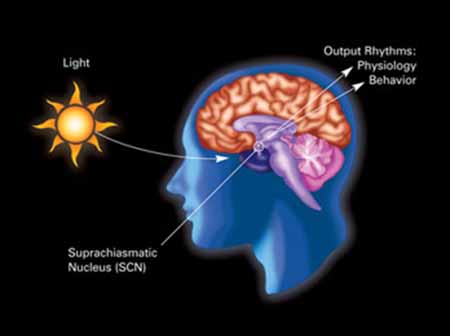
Circadian rhythms help everything from plants to humans coordinate with the daily light-dark cycle, but how this natural clock keeps accurate time, or why it goes awry in people with sleep disorders, is still under investigation. New findings suggest that a molecular switch balances the activity of two key proteins that keep the central timepiece of the clock -- the daily accumulation and degradation of the PER2 protein -- on schedule.
Earth's daily rotation period encoded in an atomic-level protein structure Science Daily - June 26, 2015
Scientists have demonstrated that Earth's daily rotation period (24 hours) is encoded in the KaiC protein at the atomic level, a small, 10 nm-diameter biomolecule expressed in cyanobacterial cells.The results of this joint research will help elucidate a longstanding question in chronobiology: How is the circadian period of biological clocks determined?
Neuroscientists identify cell type in the brain that controls body clock circadian rhythms PhysOrg - March 17, 2015
UT Southwestern Medical Center neuroscientists have identified key cells within the brain that are critical for determining circadian rhythms, the 24-hour processes that control sleep and wake cycles, as well as other important body functions such as hormone production, metabolism, and blood pressure. Circadian rhythms are generated by the suprachiasmatic nucleus (SCN) located within the hypothalamus of the brain, but researchers had previously been unable to pinpoint which of the many thousands of neurons in the region were involved in controlling the body's timekeeping mechanisms.
DNA clock helps to get measure of people's lifespans Science Daily - February 3, 2015
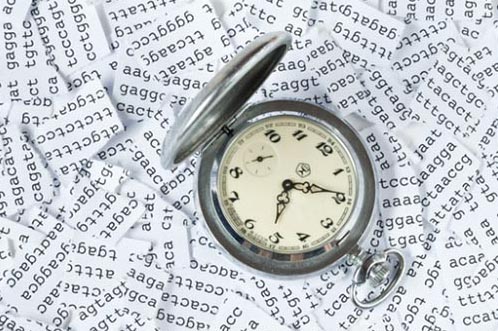
Scientists have identified a biological clock that provides vital clues about how long a person is likely to live. A biological clock that provides vital clues about how long a person is likely to live has been discovered by researchers. Researchers studied chemical changes to DNA that take place over a lifetime, and can help them predict an individual's age. By comparing individuals' actual ages with their predicted biological clock age, scientists saw a pattern emerging.
Biological clock able to measure age of most human tissues PhysOrg - October 21, 2013
A newly discovered biological clock measures aging throughout the body. While earlier clocks have been linked to saliva, hormones and telomeres, the new research is the first to identify an internal timepiece able to accurately gauge the age of diverse human organs, tissues and cell types. Unexpectedly, the clock also found that some parts of the anatomy, like a woman's breast tissue, age faster than the rest of the body.
The Link Between Circadian Rhythms and Aging: Gene Associated With Longevity Also Regulates the Body's Circadian Clock Science Daily - June 20, 2013
Human sleeping and waking patterns are largely governed by an internal circadian clock that corresponds closely with the 24-hour cycle of light and darkness. This circadian clock also controls other body functions, such as metabolism and temperature regulation. Studies in animals have found that when that rhythm gets thrown off, health problems including obesity and metabolic disorders such as diabetes can arise. Studies of people who work night shifts have also revealed an increased susceptibility to diabetes.
The rhythm of everything PhysOrg - June 18, 2013
Dawn triggers basic biological changes in the waking human body. As the sun rises, so does heart rate, blood pressure and body temperature. The liver, the kidneys and many natural processes also begin shifting from idle into high gear. Then as daylight wanes and darkness descends, these processes likewise begin to subside, returning to their lowest levels again as we sleep. These internal biological patterns are tightly linked to an external cosmic pattern: the earth's rotation around the sun once every 24 hours. This endless loop of light and darkness and the corresponding synchrony of internal and external clocks, are called circadian rhythms, from "circa diem," Latin for "approximately a day." Circadian rhythms influence almost all living organisms, from bacteria to algae, insects, birds and, as is increasingly understood by science, humans beings.
Scientists Map the Wiring of the Biological Clock Science Daily - June 6, 2013
Daily rhythms of sleep and metabolism are driven by a biological clock in the suprachiasmatic nucleus (SCN), a structure in the brain made up of 20,000 neurons, all of which can keep daily (circadian) time individually. If the SCN is to be a robust, but sensitive, timing system, the neurons must synchronize precisely with one another and adjust their rhythms to those of the environment. Herzog's lab has discovered a push-pull system in the SCN that does both. In 2005 they reported that the neurons in the clock network communicate by means of a neuropeptide (VIP) that pushes them to synchronize with one another.
Circadian Rhythms Can Be Modified for Potential Treatment of Disorders Science Daily - January 23, 2013
UC Irvine-led studies have revealed the cellular mechanism by which circadian rhythms -- also known as the body clock -- modify energy metabolism and also have identified novel compounds that control this action. The findings point to potential treatments for disorders triggered by circadian rhythm dysfunction, ranging from insomnia and obesity to diabetes and cancer. Circadian rhythms of 24 hours govern fundamental physiological functions in almost all organisms.
Ancient body clock discovered that helps to keep all living things on time PhysOrg - January 27, 2011
The mechanism that controls the internal 24-hour clock of all forms of life from human cells to algae has been identified by scientists. Not only does the research provide important insight into health-related problems linked to individuals with disrupted clocks - such as pilots and shift workers - it also indicates that the 24-hour circadian clock found in human cells is the same as that found in algae and dates back millions of years to early life on Earth.